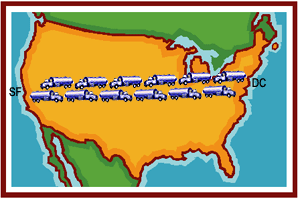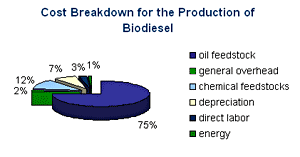Pacific Southwest, Region 9
Serving: Arizona, California, Hawaii, Nevada, Pacific Islands, Tribal Nations
 Learn About Biodiesel
Learn About Biodiesel
It is less toxic than table salt and biodegrades as fast as sugar.
On This Page:
- What is biodiesel?
- Why is Region 9 interested in biodiesel?
- Are there any air quality benefits to using biodiesel?
- Is biodiesel toxic?
- Why use waste cooking oil and not virgin vegetable oil?
- How much waste cooking oil is out there?
- What are the current waste disposal methods for used cooking oil?
- Does biodiesel cost more than other fuels?
- Is biodiesel the same thing as straight vegetable oil?
- Can I put biodiesel in my diesel-run car?
What is biodiesel?
Biodiesel is an alternative fuel made from virgin vegetable oil or used vegetable oil. Even animal fats like beef tallow and fish oil can be used to make biodiesel fuel. Unlike fossil fuels, biodiesel is renewable and can be made domestically. Biodiesel may be blended with conventional diesel to get different blends such as B2 (2% biodiesel and 98% conventional diesel) or B20 (20% biodiesel) or it can be used as 100% biodiesel (B100).
Why is Region 9 interested in biodiesel?
Biodiesel is cleaner-burning than petroleum diesel. It reduces the emission of harmful air pollutants-in particular asthma-causing soot. Furthermore, when used cooking oil is recycled to produce biodiesel, billions of gallons of waste grease can be diverted from landfills and municipal water pipes, improving the quality of both air and water.
Are there any air quality benefits to using biodiesel?
Yes! When compared to conventional diesel, biodiesel significantly reduces air pollution emissions of sulfur dioxide, particulate matter (soot), and carbon dioxide.
Average Emissions of biodiesel Fuel Compared to Petroleum-based Diesel |
||
|---|---|---|
| Emission Type | 100% Biodiesel | 20% Biodiesel |
| Sulfates (SOx) causes acid rain |
-100% | -20% |
| Particulate Matter (PM) contributes to soot |
-50% | -10% |
| Carbon Monoxide (CO) leads to greenhouse gases |
-50% | -10% |
| Nitrogen oxides (Nox) Forms smog |
+10% | 0% |
Is biodiesel toxic?
Biodiesel is non-toxic, biodegradable and creates less air pollution than petroleum diesel. It is less toxic than table salt and biodegrades as fast as sugar.
See the full news release of July 22, 2004, which includes this statement.
Why use waste cooking oil and not virgin vegetable oil?
Although both virgin oils and used cooking oils are used to make biodiesel, used cooking oil diverts waste from landfills and sewer pipes and converts it into an energy source. In metropolitan areas where restaurants, cafés, and cafeterias are abundant, waste cooking oil can be harvested from restaurants as an "urban crop" instead of using virgin soybean oil.

Biodiesel of Las Vegas
Biodiesel life-cycle (PDF) (213 pp., 1.8M)
How much waste cooking oil is out there?

Large amounts! Hotels and restaurants in the United States generate 3 billion gallons of waste cooking oil per year. This amount could fill tanker trucks arranged bumper-to-bumper from San Francisco to Washington D.C. and back!
What are the current waste disposal methods for used cooking oil?
Currently, some restaurants are required to collect the grease in traps and pay to have it hauled off by a renderer. Some of the grease is used to supplement feed for farms; however, a lot ends up in landfills. Where grease traps are not required, restaurants and cafes may dump their used cooking oil down the drain where it often causes build-ups and blockages in municipal sewer pipes.
Does biodiesel cost more than other fuels?
Although biodiesel costs more than petroleum diesel in some places, the price gap continues to narrow. The price falls considerably when waste cooking oil is used, since 75% of the price of biodiesel comes from the oil feedstock. If waste cooking oil is used, this economic advantage can be moved to the price of the fuel at the pump.
Is biodiesel the same thing as straight vegetable oil?
No. Biodiesel is made through a process called transesterification where vegetable oil is combined with an alcohol and a catalyst (lye) to create biodiesel and glycerol.
Can I put biodiesel in my diesel-run car?
Yes! Any diesel car may be run on biodiesel with little to no modifications. Adjustments may include:
Rubber hose and gasket replacement. In older cars (15 years or older) rubber gaskets and hoses will need to be replaced, as biodiesel has a tendency to degrade rubber.
Replacement of fuel filters. When biodiesel is first used an increase in deposits within the engine system may occur, so more frequent replacement of fuel filters may be necessary.
Purchase and use of American Society for Testing and Materials (ASTM) compliant biodiesel. ASTM compliant fuel ensures quality fuel that meets specified alternative fuel standards.
Find an alternative fueling station location near you:U.S. Department of Energy's Alternative Fuel Station Locator
National Biodiesel Board's Retail Fueling Site
Biodiesel Hotline to find retail availability anywhere in the United States
1-
866-BIODIESEL (246-3437) — staffed 24 hours a day, 7 days a week

